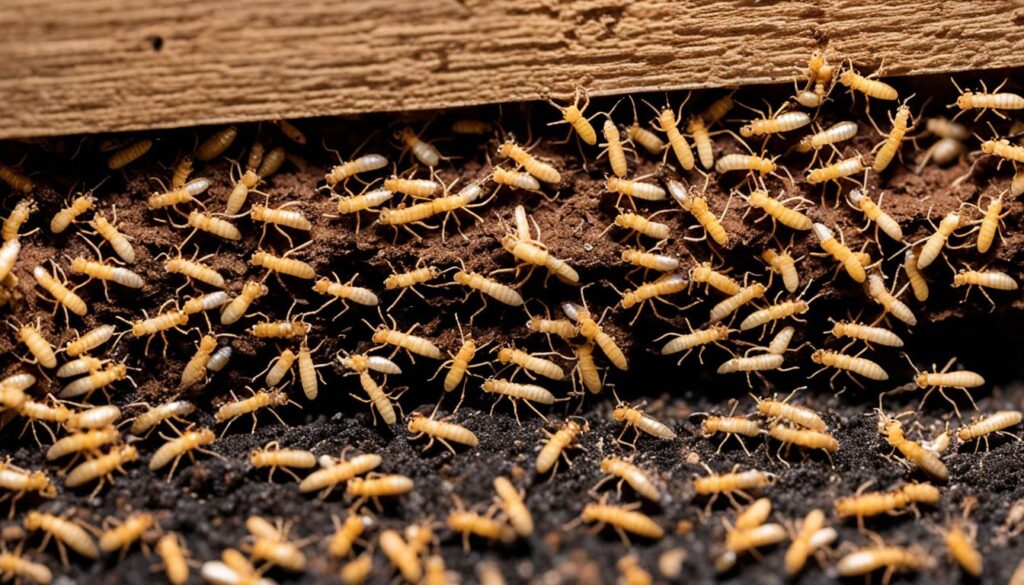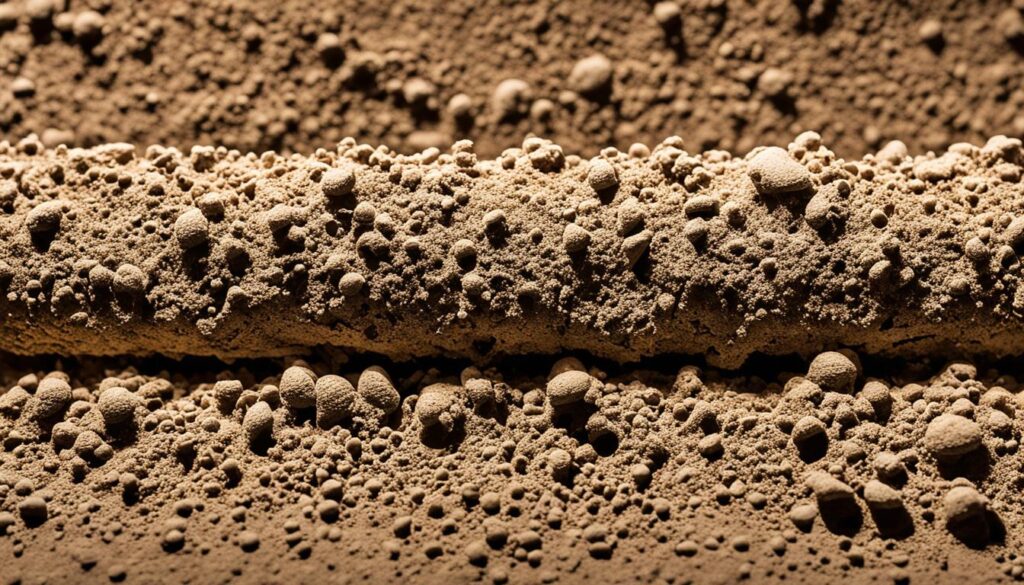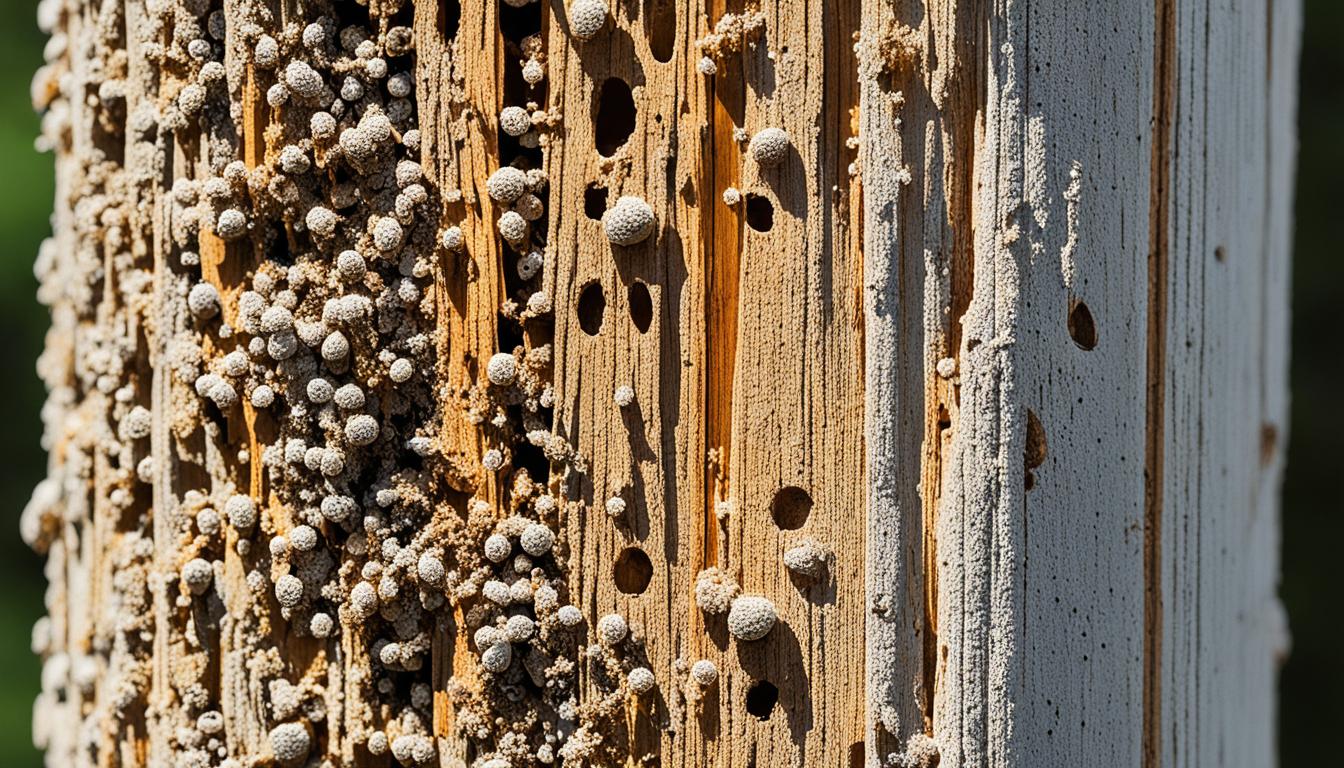How do you know if your home has termites? These sneaky pests can be hard to spot. They hide in wood and damage can occur before you notice. But, if you learn the signs, you can catch them early and reduce damage. Do you know what to check for?
Key Takeaways
- Termites can live in your home for a long time before being detected.
- Signs of termite infestations include discarded wings, hollow or blistering wood, termite droppings, and mud tubes.
- Identifying these signs early can help you catch an infestation and minimize damage.
- Both drywood and subterranean termites can be difficult to spot, but have unique signs to look for.
- A professional inspection is often necessary to confirm the presence of termites and determine the best course of action.
Why You Should Be Concerned About Termite Infestations
Termite damage is a huge problem for many homes in the United States. These pests cause over $5 billion in damage each year. This makes them one of the worst threats to homes and buildings. Sadly, most insurance plans don’t include termite damages. Homeowners are often left with the bill for these costly repairs.
Termites can infest almost any property, putting homeowners at risk. They love moist and quiet places. These pests enter through tiny cracks, build colonies quickly, and harm a home’s structure. It’s critical to spot them early. Otherwise, they can cause severe damage within just a few years. This damage might need expensive fixes or might need to replace parts of a house.
Knowing the signs of a termite problem is key to keeping your home safe. Look out for mud tubes, flying termites, wings left behind, and damaged wood. Being alert and acting fast can help homeowners avoid big costs. This includes expenses from termite damage not being covered by insurance.
| Termite Infestation Warning Signs | Potential Consequences |
|---|---|
|
|
Being aware of why early detection matters and taking steps to stop and treat termites is crucial. It protects a homeowner’s biggest investment. More importantly, it helps avoid the financial and emotional hardship that often follows termite damage.
Early Warning Signs of Termites
Spotting the early signs of termites is key for homeowners. Watch for termite swarmers – winged termites. They look for mates emerging from their nests. Seeing piles of their wings by your home’s base means there’s a termite colony doing its thing there.
Identifying Termite Swarmers and Discarded Wings
Termite swarmers are male and female termites that fly away together. It happens a lot in spring or fall. You might see them by your windows or inside. They lose their wings after they mate, which is why you find heaps of wings around.
What Termite Swarmers Look Like
Termite swarmers are smaller than ants and have equal-sized wings. They are thin and often light in color. Remember, ants have different wing sizes and a thin waist. Knowing this can help you tell termites apart from harmless flying bugs.
When and Why Swarmers Emerge
Termite swarms happen in warm months, with some like Formosan termites coming out at dusk. They leave to find places for new colonies. Knowing about swarms can alert you to possible infestations early and take proactive steps.
Finding swarmers and their wings early can prevent big home damage. Stay alert and you can keep your home safe from these tiny invaders. It’s all about knowing what to watch out for and how to act quickly.

Signs of Termite Damage to Wood and Drywall
Termite infestations can severely harm your home’s wooden parts and drywall. Knowing the signs is crucial if you think termites might be around. We’ll cover key indicators of termite wood damage and termite drywall damage here.
Hollow or Blistering Wood
When wood feels hollow or looks blistered, it could be termites. They munch on wood from inside, leaving a thin outer layer. Also, strange cracks in walls might appear, as termites feed on drywall’s cellulose.
Bubbling Paint and Pinhole Holes in Drywall
Bubbling paint and tiny holes in drywall are clear signs of termites. These pests can also affect baseboards, floors, ceilings, and beams. This could lead to a weaker structure that sags and cracks over time.
| Termite Wood Damage | Termite Drywall Damage |
|---|---|
|
|
Spotting termite damage early helps you act quickly to protect your home. The faster you deal with termites, the less damage and repair cost you’ll face.
Termite Droppings and Frass
Do you know how to spot a termite problem in your house? Look out for termite droppings, also called frass. These tiny, wood-colored pellets are termite poop. They can tell you a lot about the size and type of termite infestation. Drywood termites, for example, leave neat piles of frass as they eat wood in your home.
Termite frass can look like sawdust at first. But there are clues that tell them apart. Termites’ droppings are usually 1 millimeter long, have six sides, and vary in color from brown to grey. Compare this to sawdust which is uneven in shape and lighter in color.
Distinguishing Frass from Sawdust
Spotting a termite problem early is key. Inspect any debris piles closely. You can do this by noticing:
- Appearance: Termite droppings are small and plague, while sawdust looks unorganized.
- Color: Termite frass comes in shades of brown to grey. Sawdust is usually lighter.
- Location: Look for frass near wooden spots like walls and furniture. Sawdust might be scattered everywhere.
- Quantity: Termites can produce a lot of frass in piles. Sawdust is less common.
If you see what looks like termite droppings, get professional help right away. Acting fast can stop a termite infestation from causing big, costly damage to your home.
Knowing how to tell termite frass from sawdust is crucial. This knowledge can help you catch a termite problem early. This way, you can address it before it gets worse.
Mud Tubes: A Telltale Sign of Subterranean Termites
Mud tubes are a big indicator that subterranean termites have invaded. Termites make these tubes to safely get to the wood they love eating. These insects are known for their love of cellulose. This is found in wood and other materials. The mud tubes keep the perfect temperature and humidity for termites as they move.
The tubes termites make can be as wide as 1 inch. They’re mostly seen on the base of houses or in crawl spaces. These paths can move up to thousands of termites in a day. A mix of dirt, wood, saliva, and waste makes their environment perfect.
Some termite mounds can be as big as four feet across. These are where winged termites start new homes. They also make drop tubes that hang between the ground and your house. These tubes are lighter and have more wood in them. They’re different from the main tubes.
If you see mud tubes, it’s a sign of termites eating your house. To stop them, get rid of wet spots and keep wood away from your house. This simple approach can help avoid the major damage termites cause.
| Termite Mud Tube Characteristics | Measurements and Details |
|---|---|
| Diameter of Mud Tubes | 1/4 to 1 inch |
| Termite Transport Capacity | Hundreds to thousands of termites per day |
| Size of Swarm Castles | Up to 4 feet wide |
| Composition of Mud Tubes | Dirt, wood, saliva, and feces |
| Characteristics of Drop Tubes | Lighter in color, more wood fibers, similar diameter to exploratory tubes |

Seeing termite mud tubes means your home is under attack. Act quickly to avoid damage and repair costs. A professional pest control person can accurately deal with the termites. They’ll find how much they spread and stop them effectively. This protects your home.
Signs of Drywood Termites Inside the Home
Drywood termites are different from subterranean ones. They live right inside the wood, creating tunnels and chambers. These tiny workers leave their poop, known as drywood termite signs and termite fecal pellets, near their homes. This poop looks like tiny salt or pepper piles, showing a drywood termite infestation is near.
Piles of Fecal Pellets
If you spot piles of dry, cone-shaped pellets, be warned. These are the termite fecal pellets left behind by drywood termites. They might be anywhere from brown to almost black and look like sand. Finding these piles means you’ve got some unwanted guests in your home.
Drywood termites prefer dry wood over wet. They often live in wood near doors, windows, or in furniture. You can tell them apart from other termites by their unique winged creatures and soldier termites.
Seeing lots of flying insects around wood, or wings and damage, is a big sign. These termites can hide and then suddenly come back in force. They’re a serious danger to houses, especially if left undetected.
Other Signs to Watch For
Termites are sneaky creatures. Their presence isn’t always clear. In addition to usual signs like swarmers and mud tubes, watch for other hints in your house.
Sticking Windows and Doors
If opening or closing your windows and doors gets harder, termites might be the reason. By eating wood frames, termites cause moisture and warping. This warping makes things stick or bind. It’s a sign of serious damage by termites.
Termite Noises and Vibrations
Termites could be making noise while they eat your home’s wood. Their soldier termites might even bang their heads to warn the colony, creating a clicking sound. You might also feel or hear vibrations from their activity, mainly at night.
Don’t overlook these subtle signs of termites. Other hints like weird sounds and clear damage can show you have an ongoing termite issue. Regular check-ups by experts are key to finding and stopping these problems early.
When to Schedule a Professional Termite Inspection
Termite infestations can be a homeowner’s worst nightmare. They cause a lot of damage and cost a lot to fix. To avoid big problems, it’s smart to be on top of this. This means calling in someone who’s an expert at the first sight of trouble.
Experts say you should get a termite inspection every year, usually in the spring. This is when termites are most active because of the warm weather. They swarm and start new colonies. If you find them early, repairs might not cost much.
If you see any of the signs of termites, like winged insects around your house, it’s time for an extra check. Sometimes, these signs are:
- Swarms of winged insects near your home
- Discarded termite wings
- Mud tubes on the exterior of your home
- Hollow or blistering wood
- Bubbling paint or pinhole holes in drywall
The average cost of a termite check is between $50 and $250. It depends on how big and where your home is. This check might sound like a lot, but fixing a termite problem is much more expensive.
If an inspection shows you have termites, don’t worry. There are ways to deal with them. Options include fumigation, bait, and chemicals. Acting fast and getting help from a good pest control company is important.
Don’t let termites ruin your home. Stay alert and get regular checks. Protect your investment by acting now.
Effective Termite Treatment and Prevention Methods
Termites can be hard to spot and may go unnoticed. It’s important to have your property checked by a pro regularly. Even without obvious signs, like swarms, a pro inspection can find any termite issues. They can also set up treatments to stop future infestations. Catching and dealing with termites early can save your home from serious costs.
HomeTeam Pest Defense has been safeguarding homes since 1996. With over 2,000 pros and 50+ branches, they complete 2 million treatments yearly. They offer many termite solutions, like soil and wood treatments and bait systems.
Soil treatment makes a barrier in the ground to stop termites, while wood treatment protects wood from them. Bait systems use stations in the soil to control termite populations. By combining these with regular checks and fixing moisture problems, you can keep your home termite-free.
